PHYSIOLOGY | IMAGES | ETYMOLOGY | TAXONOMY | GEOGRAPHY | BEHAVIOR | DIET | REPRODUCTION | ECOLOGY | CONSERVATION | FAUNAFACTS | VIDEO | SOURCES

The leopard is an arboreal, opportunistic feline carnivore native to Africa and Asia. With a spotted pelage of black rosettes, each leopard has individual markings that vary geographically amongst the 8 subspecies. Leopards are ambush predators and feast on prey in trees.
Physiology
The leopard’s coat ranges from tawny or light yellow in warm, dry habitats to reddish-orange in dense forests. The pelt is covered with black rosettes, which are circular in East Africa and square in South Africa. Leopards have solid black spots on their chest, feet, and face and rings on their tail. Each individual has a unique coat, which can be used for identification.
Black panthers, which are most populous in humid forests, are leopards with recessive melanistic genes.
The body size and color patterns of leopards vary geographically and probably reflect adaptations to particular habitats. Subspecies are distinguished according to unique pelage characteristics. Savannah and woodland leopards tend to be relatively large while mountain and desert leopards tend to be relatively small.
Leopards are sexually dimorphic as males tend to be larger than females. Females range in body mass from 17 to 58 kilograms and in length from 1.7 to 1.9 meters. Males range in mass from 31 to 65 kilograms and in length from 1.6 to 2.3 meters.
Leopards have short legs relative to their long body. The leopard’s scapula has specialized attachment sites for climbing muscles.
They have a broad head, and their massive skull allows for powerful jaw muscles. They have small round ears, long whiskers extending from dark spots on the upper lip, and long whiskers in their eyebrows that protect their eyes while moving through dense vegetation.
Wild leopards may live to be 10 to 12 years old, with the oldest known individual being 17 years old. In captivity, leopards can live to be 21 to 23 years old, with the oldest known individual being 27 years old.

SEXUAL DIMORPHISM
Larger MalesBODY LENGTH
1.6-2.3 m / 5.2-7.5 ftBODY MASS
17-65 kg. / 37-143 lb.LIFESPAN
10-23 yr.GENERATION LENGTH
7.42 yr.LOCOMOTION
Digitigrade

Images
Taxonomy
The taxonomy for the leopard is currently under review by the International Union for Conservation of Nature and Natural Resources (IUCN) Species Survivial Commission (SSC) Cat Classification Task Force of the Cat Specialist Group.
Following Carl Linnaeus’ first description, 27 leopard subspecies were proposed by naturalists between 1794 and 1956.
In 2005, eight subspecies were recognized based mainly on a genetic mitochondrial molecular study: P. p. delacouri (Indochinese), P. p. fusca (Indian), P. p. japonensis (Northern Chinese), P. p. kotiya (Sri Lankan), P. p. melas (Javan), P. p. nimr (Arabian), P. p. orientalis (Amur), and P. p. pardus (African).
There was discretion as to whether or not P. p. saxicolor (Southwest Asian) should be recognized as a ninth genetically distinct subspecies. The recognition of Panthera pardus melas, the Javan leopard, and Panthera pardus nimr, the Arabian leopard, was based on very small sample sizes and is considered tentative.
Based on morphological analysis, Panthera pardus tulliana, the Anatolian, Caucasian, or Persian leopard was recognized in western Turkey and Panthera pardus sindica was recognized in Pakistan, and possibly also parts of Afghanistan and Iran. Panthera pardus ciscaucasica was considered as the senior synonym for Panthera pardus saxicolor.
There are conflicting results from different studies suggesting that more comprehensive sampling is required from throughout the leopard’s range, taking advantage of museum specimens
of known provenance. Until such a study is carried out, the IUCN SSC Cat Classification Task Force of the Cat Specialist Group proposes the following conservative arrangement of subspecies: P. p. delacouri (Indochinese), P. p. fusca (Indian), P. p. kotiya (Sri Lankan), P. p. melas (Javan), P. p. nimr (Arabian), P. p. orientalis (Amur), P. p. pardus (African), and P. p. tulliana (Southwest Asian).
KINGDOM
AnimaliaPHYLUM
ChordataCLASS
MammaliaORDER
CarnivoreFAMILY
FelidaeGENUS
PantheraSPECIES
pardusSUBSPECIES (8)
P. p. pardus (African), P. p. delacouri (Indochinese), P. p. fusca (Indian), P. p. kotiya (Sri Lankan), P. p. melas (Javan), P. p. nimr (Arabian), P. p. orientalis (Amur), P. p. tulliana (Southwest Asian)
Etymology
The common name leopard is derived from the Old English word leuparz used in the poem The Song of Roland written in the late 8th century. It’s thought to be a Greek compound of λέων leōn meaning lion and πάρδος pardos. The leopard’s scientific name, Panthera pardus is derived from the Greek πάρδαλος pardalosmeaning spotted.
Leopards are also known as panthers. Black panthers, which are most populous in humid forests, are leopards with recessive melanistic genes. The word ‘panther‘ is derived from the Latin word panther and the ancient Greek πάνθηρ pánthēr. The phonetically similar sounding Sanskrit word पाण्डर pând-ara means pale yellow, whitish, white.
ALTERNATE
PantherGROUP
Leap, ProwlFEMALE
LeopardessYOUNG
Cub
Region
Leopards are widely distributed across Africa and Asia, but populations have become reduced and isolated, and they are now extirpated from large portions of their historic range. Leopards are declining in parts of their geographic range due to habitat loss and fragmentation, and hunting for trade and pest control.
Leopard distribution in North Africa has been restricted by 97% of their former range with only remnant, isolated populations remaining. An adult male leopard was killed in the Elba region of southeastern Egypt in retaliation for livestock depredation. Leopards are thought to be extirpated from Morocco.
Leopard distribution in West Africa has been dramatically reduced. This reduction is likely due to habitat fragmentation, but also more rigorous survey efforts have confirmed presence and likely absence across the region.
In the Democratic Republic of the Congo of Central Africa, leopard range was largely reduced in areas of increased human influence and areas relatively easy to access and therefore open to illegal hunting and bushmeat trade.
The distribution of leopards in East Africa has been reduced, in particular in Somalia, Kenya, Ethiopia and central Tanzania. It is thought that leopards are absent from the southeastern boundary of Lake Victoria to Central Tanzania.
In southern Africa, the so-called stronghold of the leopard, there is no evidence to suggest that leopard populations have remained stable. In Zimbabwe, much leopard range has disappeared due to the resettlement of private farmland and subsequent loss of prey populations. Regional range losses are estimated at approximately 21% in southern Africa. It is suspected that suitable leopard range has been reduced by more than 30% worldwide in the last three generations of 22.3 years. Generation length is calculated as 7.42 years, based on a formula and data from wild leopard populations.
Leopard range has been significantly reduced in southeast and East Asia. The species is likely extirpated in the Musandam Peninsula of Oman and UAE. Leopards are probably extinct in Jordan, UAE and Egypt’s Sinai Peninsula, with the possibility of rare forays from the Negev.
Evidence of a breeding leopard population is still uncertain in the Elba region of southeastern Egypt. Continued camera-trapping efforts have failed to capture the presence of leopard in the Sinai since 1995. The presence of leopards was confirmed in the Ahaggar Mountains of Algeria from the genetic testing of one scat sample in 2005 but no presence has been confirmed since then.
Leopards have been confirmed in Niger along the southwestern border with Benin and Burkina Faso but previous reports in Air and Tenere National Reserves are unconfirmed. Leopards are generally restricted to a few protected areas from Senegal in the west to Nigeria in the east. Leopards have been reported in the south of Senegal including Parc National de Niokolo-Koba. In Sierra Leone, there are small remnant populations near Outamba Kilimi National Park and Gola National Forest as well as the eastern boundary with Guinea/ Liberia. Leopard populations in Liberia have been recorded in Lofa-Mano National Park in the west and Sapo National Park in the east. In Ghana, Leopards are found along the boundary with Côte d’Ivoire and Mole National Park in the north and west. In Benin, leopard are found along the northern boundary. Leopards are nearly absent from Nigeria.
In Cameroon, leopards are found in the northern and southern portions of the country. In Gabon, leopards are found throughout the country with small absent pockets in the southeast and southwest. In the Central African Republic (CAR) leopards are found in the southwest, central and eastern portions of the country. Leopards are found throughout South Sudan with the exception of the Sudd wetland.
In East Africa, there are possible remnant populations in Djibouti, Eritrea, and North Sudan. Leopards are nearly absent from Somalia. Leopards are found throughout southern Ethiopia, parts of Uganda and the west, central, and southern portions of Kenya. In Tanzania, leopards are found throughout the Serengeti-Ngorogoro Crater system and to the south and west.
Southern Africa likely has the healthiest leopard populations of their entire range. It is generally thought that Angola, Zambia, Zimbabwe, and Mozambique have declining but healthy leopard populations outside of human-dominated areas.
In Namibia, leopards inhabit most of the country with the exception of the highly populated northern region, the arid southeast farmlands, and the desert coast. Botswana has a continuous leopard population in the North and West. In South Africa, leopards are found along the boundaries with Namibia, Botswana, Zimbabwe, and Mozambique with dense populations located in the Limpopo region. Leopards are also located in the Cape provinces of South Africa.
The main stronghold for the Arabian leopard (Panthera pardus nimr) is the continuous tract of the Dhofar area in southwestern Oman and the Hawf area in northeastern Yemen. There are also small, isolated populations in Saudi Arabia. In 2006, leopard populations were estimated at eight individuals in Israel’s Judean Desert and Negev Highlands respectively, however, they have not been confirmed since.
Recent surveys found that leopards have a wide distribution in Iran, mostly in the region of the two mountain chains consisting of Alborz running northwest to northeast and Zagros from northwest to the south. Their presence is also recorded in Golestan National Park, Iran which is located in the northeastern part of Iran near the border with Turkmenistan. A few recently confirmed records from Iraq and Turkey are restricted to the mountainous areas of Kurdistan, where leopards are known to be scarce. There are numerous camera-trap records dated 2013-2014 confirming the presence of a small population in the Zangezur Ridge shared by Armenia and Azerbaijan. Two individuals are recorded in Talysh Mountains of southeastern Azerbaijan. There is recent camera trapping evidence from Nakhchivan Autonomous Republic, Azerbaijan. Recently, a leopard was videotrapped in North Ossetia, Georgia. There are no confirmed recent records in Dagestan although leopards definitely lived there in low numbers in the 1980s and the last confirmed photograph was taken in 2009.
There is some indication of the leopard’s presence in the Babatag and Kugitang mountains of Uzbekistan. A confirmed record of leopard was obtained in Afghanistan in the Bamyan province in 2011 in a camera trap image.
In Pakistan, leopards also inhabits broken hilly or mountainous country throughout Waziristan, Baluchistan and Sindh Kohistan in association with acacia scrub forest. A recent study using DNA from scats found leopard presence in northeast Pakistan from the Ayubia National Park. Leopards occur widely in the forests of Bhutan and Nepal. Leopards are widespread across India and Sri Lanka occurring inside and outside protected areas.
The North China Leopard is restricted to small, isolated protected areas in Central China in the Ningxia, northern Hebei, Shanxi, Shaanxi, northern Henan, western Sichuan, southern Qinghai and eastern Tibet regions. Leopards of southeast Asia have been confirmed in protected areas in Thailand, Myanmar, Malaysia, Cambodia, and southern China but are likely absent from Lao PDR and Viet Nam. Some recent information indicates that they are still present in most forested regions of the island of Java, Indonesia but in very low numbers. In the Russian Far East, leopards occur in a large area of about 7,000 km² along the eastern slopes of the East Manchurian Mountains on the border with China but their numbers are likely to be very low.
EXTANT
Afghanistan, Angola, Armenia, Azerbaijan, Bangladesh, Benin, Bhutan, Botswana, Burkina Faso, Burundi, Cambodia, Cameroon, Central African Republic, Chad, China, Congo, Côte d’Ivoire, Djibouti, Egypt, Equatorial Guinea, Eritrea, Eswatini, Ethiopia, Gabon, Ghana, Guinea, Guinea-Bissau, India, Indonesia, Iran, Iraq, Kenya, Liberia, Malawi, Malaysia, Mali, Mozambique, Myanmar, Namibia, Nepal, Niger, Nigeria, Oman, Pakistan, Russia, Rwanda, Saudi Arabia, Senegal, Sierra Leone, Somalia, South Africa, South Sudan, Sri Lanka, Sudan, Tanzania, Thailand, Turkey, Turkmenistan, Uganda, Yemen, Zambia, ZimbabwePOSSIBLY EXTINCT
Gambia, Isreal, Korea, Lao, Lesotho, Tajikistan, VietnamEXTINCT
Hong Kong, Jordan, Korea, Kuwait, Lebanon, Mauritania, Morocco, Singapore, Syria, Togo, Tunisia, United Arab Emirates, UzbekistanUNCERTAIN
Algeria, Georgia
Habitat
Leopards occur in the widest range of habitats among any of the Old World Cats. They inhabit a variety of terrain including forests, savanna, shrubland, grassland, rocky areas, and deserts. They are most populous in mesic woodlands, grassland savannas, and forests, but also occupy mountainous, scrub, and desert habitats.
They are found in the desert and semi-desert regions of southern Africa in Namibia and Botswana. There are remnant populations in the arid regions of North Africa in Egypt, as well as the Arabian Peninsula. They persist in rugged montane regions of southwest Asia in Iran, in a varied range of landscapes in India and in the savanna grasslands of East and southern Africa.
Leopards live in mountainous environments up to an altitude of 4,600 meters on Mt. Kenya and 5,200 meters in the Himalayas. They have been recorded at 5638 meters on Mt. Kilimanjaro.
Leopards also thrive in the rainforests of West and Central Africa as well as Sri Lanka and southeast Asia. A remnant leopard subpopulation also persists in the snowy regions of the Russian Far-East. Leopard subpopulations also occur in suburban and urban environments in India and parts of sub-Saharan Africa.
Because leopards prefer to hunt in areas that provide sufficient cover despite higher prey densities elsewhere when sympatric with larger competitors, they favor trees throughout their entire geographic distribution. They are most comfortable in the lower forest canopy where they often feed. They descend from the canopy head-first.
FOREST
Temperate, Subtropical/Tropical Dry, Subtropical/Tropical Moist Lowland, Subtropical/Tropical Mangrove Vegetation Above High Tide Level, Subtropical/Tropical Swamp, Subtropical/Tropical Moist MontaneSAVANNA
Dry, MoistSHRUBLAND
Temperate, Subtropical/Tropical Dry, Subtropical/Tropical Moist, Subtropical/Tropical High AltitudeGRASSLAND
Subtropical/Tropical Dry, Subtropical/Tropical High AltitudeROCKY AREAS
Inland Cliffs, Mountain PeaksDESERT
Hot, Temperate
Co-Habitants

Lion 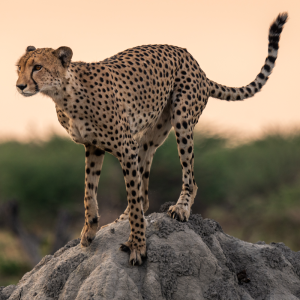
Cheetah 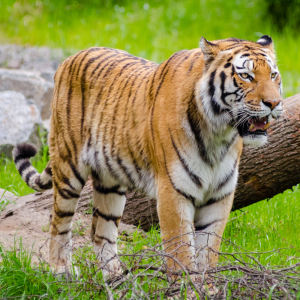
Tiger 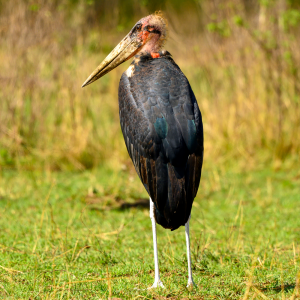
Marabou 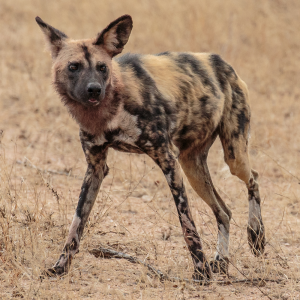
African Wild Dog 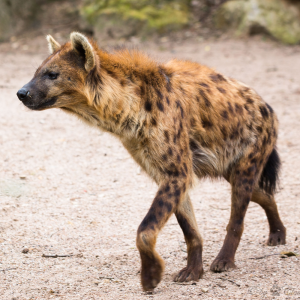
Spotted Hyaena 
Impala 
Dhole 
Grey Wolf
Behavior
Leopards are solitary, nocturnal carnivores. Although they sometimes hunt during overcast days, they are less diurnal in areas close to humans in comparison to uninhabited areas. To avoid attacks from potential predators, leopards tend to hunt at different times of the day.
Leopards are comfortable in water and are adequate swimmers. They are facultative drinkers and obtain much of their water requirements from ingested prey.
Although leopards are silent most of the time, they communicate with conspecifics by growling, roaring, and spitting when aggravated. They also make a rasping cough to advertise their presence to conspecifics. Leopards may give a hoarse, rasping cough at repeated intervals to advertise their presence to conspecifics. Males use this unique call to announce territorial boundaries. If another leopard is in the vicinity, it may answer with a similar vocalization and continue vocalizing as it exits the area. Males also grunt at each other and females call to potential mates when in estrous. Some leopards may purr while feeding or when content.
Similar to other mammalian species, the home ranges of male leopards are larger and tend to overlap with those of multiple females. Home ranges also tend to be larger in arid conditions. Male leopards have a core range of about 12 kilometers squared, with a home range of about 35 kilometers squared. Females have a core range of about 4 kilometers squared with a home range of about 13 kilometers squared. In Namibia, the home ranges of males overlapped 46% of the time and those of females overlapped about 35% of the time. Leopards mark their territory with urine, feces, and claw marks.
CIRCADIAN RHYTHM
Nocturnal
Diet
Leopards generally prey upon mid-sized ungulates, which includes small antelopes (Bovidae), gazelles (Gazella), deer (Cervidae), pigs (Sus), primates (Primates) and domestic livestock. Leopards prefer prey that weigh between 10 and 40 kilograms. Leopards are opportunistic carnivores and eat birds (Aves), reptiles (Reptilia), rodents (Rodentia), arthropods (Arthropoda), and carrion when available. They are also known to scavenge from cheetahs (Acinonyx jubatus), solitary hyaenas (Hyaenidae), and smaller carnivores as well. When natural prey abundances are low, leopards have been known to kill livestock. Injured or sickly leopards have also been known to hunt humans as easy prey.
Leopards are ambush predators and have advanced vision and hearing which makes them especially adept at hunting in dense forests. Many of the characteristics that make leopards great predators also serve as excellent predator defense mechanisms. For example, a leopard’s spots allows them to travel inconspicuously and avoid detection. When hunting, a leopard moves with a slow, crouching walk and approaches potential prey by crouching low to the ground. The predator will get as close as 3 to 10 meters to its prey before pouncing, not allowing the target a chance to react.
The leopard’s tremendous strength allows it to tackle prey up to 10 times its own weight.
Although leopards can run at bursts of up to 60 kilometers per hour and can jump more than 6 meters horizontally and 3 meters vertically, they are not likely to chase prey.
Once a leopard captures a prey item, it immediately breaks the prey’s neck, causing paralysis. After breaking the neck, the leopard asphyxiates the prey and carries the carcass to a secluded feeding location, typically in a nearby tree.
Leopards may also cover prey carcasses in leaves and soil. Leopards are known to cache food and may continue hunting despite having multiple carcasses already cached.
PREFERENCE
GeneralistSTYLE
Ambush
Prey

Impala
Reproduction
The reproductive season of the leopard is year-round but peaks during the rainy season in May. In China and southern Siberia, leopards mainly breed in January and February.
Leopards are promiscuous and polygynandrous, as both males and females have multiple mates.
Females attract potential mates by excreting pheromones in their urine. Females initiate mating by walking back and forth in front of a male and brushing up against him or swatting him with her tail. The male then mounts the female while frequently biting her nape.
Copulation lasts an average of three seconds with six minute intervals between each copulation bout. A single breeding pair may copulate up to 100 times per day for several days, during which time they share food resources.
Females are in estrus for 7 days and have a 46 day long cycle. Gestation last 96 days and females usually give birth once every 15 to 24 months. Typically, females stop reproducing around 8.5 years old.
Leopard cubs weigh less than 1 kilogram at birth, and their eyes remain closed for the first week. They have a smoky gray coat and their rosettes are not yet distinct.
Mothers leave their cubs in the protection of dense bush, rock clefts, or hollow tree trunks for up to 36 hours while hunting and feeding. They move den sites frequently, which helps prevent cubs from falling prey to lions (Panthera leo) and other predators. Mothers share less than a third of their food with their cubs.
Cubs learn to walk at 2 weeks of age and regularly leave the den at 6 to 8 weeks old, around which time they begin to eat solid food. Cubs are completely weaned by 3 months old and independent at just under 20 months old. Often, siblings maintain contact during the early years of independence. Territories are flexible and young may linger in their natal area.
Survival rates for cubs range from 41% to 50%.
BREEDING SEASON
Year-Round, Peaks in MayBREEDING INTERVAL
15-24 MonthsESTROUS CYCLE
7 DaysCOPULATION
3 SecondsPARENTAL INVESTMENT
MaternalGESTATION
96 DaysLITTER
2-3WEANING
3 MonthsINDEPENDENCE
20 MonthsSEXUAL MATURITY
2-2.5 Years
Ecology
Leopards positively contribute to the ecosystem by helping to control baboon populations and dispersing seeds that stick to their fur. Leopards are economically important for humans as they can be seen in national parks throughout Asia and Africa.
Lions (Panthera leo), tigers (Panthera tigris), spotted hyaenas (Crocuta crocuta), and African wild dogs (Lycaon pictus) compete with leopards for food. These species also prey upon leopard cubs and are capable of killing adult leopards. Typically, when an adult is killed it is due to a territorial confrontation.
Many of the characteristics that make leopards great predators also serve as excellent predator defense mechanisms. For example, a leopard’s spots allows them to travel inconspicuously and avoid detection. When competition for larger prey items is high, leopards prey on smaller animals, which reduces interspecific competition. They also avoid attacks from potential predators by hunting at different times of the day and avoiding areas where potential predators are most populous.
Leopards are host to many common felid parasites, including lung flukes (Paragominus westermani), flat worms (Pseudophyllidea), spirurian nematodes (Spiruroidea), hookworms (Ancylostomatidae), lung worms (Aelurostrongylus), intestinal and hepatic parasites (Capillaria), and parasitic protozoa (Sarcocystis).
Humans are the primary predators of leopards.
In South-east and East Asia, poaching for leopard prey and targeted leopard hunts for the wildlife trade market are taking place. Leopards are often captured for the pet trade and are targeted and hunted as trophy animals for their fur. A regional survey found that leopards in India have been poached at a rate of four individuals per week for the illegal wildlife trade. The illegal trade of leopard parts was comparable to that of tigers (Panthera tigris) in Asian range States and derivative seizures with an average of 3.5 leopards seizure cases per month in India since 2000. Preliminary data suggest that the illegal trade in leopard skins for cultural regalia is rampant in southern Africa. It is suggested that 4,500-7,000 leopards are harvested annually to fuel the demand for leopard skins by followers of the Nazareth Babtist (Shembe) Church only. Poorly managed trophy hunting adds to pressure on local leopard populations. Trophy hunting was a key driver of leopard population decline prior to intervention in northern KwaZulu-Natal. Similarly, Leopards are over-harvested across much of their range in Limpopo Province, South Africa.
Chiefs and warriors from tribal cultures throughout the leopard’s geographic range wear their fur as a symbol of honor and courage. Tribal medicine men and women suggest leopard skins as a remedy for bad omens.
Retaliatory killings of leopards by farmers protecting their livestock are not uncommon.
MEDICINE
Local, National, InternationalSPORT HUNTING/SPECIMEN COLLECTING
National, InternationalWEARING APPAREL, ACCESSORIES
National, International
Predators

Human 
African Wild Dog 
Lion 
Spotted Hyaena 
Tiger
Conservation
Due to their wide geographic range, secretive nature and habitat tolerance, leopards are difficult to categorize as a single species.
The leopard meets the A2cd criterion for Vulnerable on the International Union for Conservation of Nature and Natural Resources (IUCN) Red List of Threatened Species, based on loss of habitat and prey, and exploitation. These causes of the suspected reduction are not well understood, have not ceased, and are likely to continue, and future decline is anticipated unless conservation efforts are taken.
Population
Evidence suggests that leopard populations have been dramatically reduced due to continued persecution with increased human populations, habitat fragmentation, increased illegal wildlife trade, excessive harvesting for ceremonial use of skins, prey base declines and poorly managed trophy hunting. Throughout North, East, and West Africa, and Middle East, East, and South-east Asia, leopards have suffered marked reductions and regional extirpations due to poaching for illegal wildlife trade, habitat loss and fragmentation, and prey loss.
Human populations have increased by 2.57% annually from 1994 to 2014 driving a 57% increase in the conversion of potential leopard habitat to agricultural areas from 1975 to 2000. Deforestation in South-east Asia has increased for palm oil and rubber plantations. These factors were not incorporated in the previous assessment and likely have a substantial impact on suitable leopard range.
Comparison of the extent of extant range presented in 2015 (8,515,935 km²) with that produced by Red List Assessors in 2007 (21,953,435 km²) yields a range reduction of 61%. However the severity of this reduction is inaccurate due to previous insufficient sampling, and the reduction has likely occurred over a longer time scale. Though our knowledge of the leopard distribution is better today than in 2008, it is still limited at the national, regional, and range-wide scales because reliable data on leopard population trends are missing from large portions of their range. We suspect, however, that at least half of the reduction translates to real and relatively recent range loss.
FRAGMENTATION
Not Fragmented
THREATS
Leopard population density across the species’ range is known to track the biomass of principle leopard prey species, medium-size and large wild herbivores.
Prey species are increasingly under threat from an unsustainable bushmeat trade, leading to collapses in prey populations across large parts of savanna Africa. A commercialized bushmeat trade has caused an estimated 59% average decline in leopard prey populations across 78 protected areas in West, East, and southern Africa between 1970 and 2005. Though ungulate populations have increased by 24% in southern Africa, potential prey numbers have declined by 52% in East Africa and 85% in West Africa. Bushmeat poaching in Mozambique and Zambia has severely reduced leopard prey inside and outside of protected areas. Many wildlife areas are suffering from substantial ungulate decline, including Zambian Game Management Areas and National Parks, maintain large mammal populations at 93.7% and 74.1% below estimated carrying capacity, respectively.
With such reductions to leopard prey, IUCN infers a more than 50% loss of leopard populations across East and West Africa.
Through extensive poaching pressure also in Asia, many prey species, such as sambar deer (Rusa unicolor) in Malaysia, are threatened with regional extirpation throughout tropical forest systems.
RESIDENTIAL & COMMERCIAL DEVELOPMENT
Housing & Urban AreasAGRICULTURE & AQUACUTLURE
Annual & Perennial Non-Timber Crops, Wood & Pulp Plantations, Livestock Farming & RanchingENERGY PRODUCTION & MINING
Mining & QuarryingTRANSPORTATION & SERVICE CORRIDORS
Roads & RailroadsBIOLOGICAL RESOURCE USE
Hunting & Trapping Terrestrial Animals, Logging & Wood HarvestingHUMAN INTRUSIONS & DISTURBANCE
War, Civil Unrest, & Military ExercisesNATURAL SYSTEM MODIFICATIONS
Fire & Fire Suppression, Dams & Water Management/Use, Other Ecosystem Modifications
ACTIONS
The concern about unsustainable trophy hunting has lately increased. South Africa has banned trophy hunting for 2016. This followed an alert by its CITES Scientific Authority that the number of leopards in the country was unknown, and that trophy hunting posed a high risk to the survival of the species.
Currently, leopards are protected throughout most of their range in west Asia; however, populations in this part of their range are too small to maintain stable growth. Although habitat reserves and national parks exist throughout their geographic range in Africa, a majority of leopards live outside these protected areas.
Leopards appear to show some resistance to minor habitat disturbances and are relatively tolerant of humans.
FaunaFacts
Video
SourceS
- African Wildlife Foundation. (2009). Leopard. African Wildlife Foundation.
- Athreya, V., Odden, M., Linnell, J. D. C., Krishnaswamy, J., & Karanth, U. (2013). Big cats in our backyards: Persistence of large carnivores in a human dominated landscape in India. Public Library of Science-One, 8(3), 1-8.
- Avgan, B., Huseynali, T. T., Ismayilov, A., Fatullayev, P., Askerov, E., & Breitenmoser, U. (2012). First hard evidence of leopard in Nakhochivan. Cat News, 57, 33.
- Balme, G. A., Batchelor, A., Woronin Britz, N., Seymour, G., Grover, M., Hes, L., Macdonald, D. W., & Hunter, L. T. B. (2013). Reproductive success of female leopards Panthera pardus: The importance of top‐down processes. Mammal Review, 43, 221-237.
- Balme, G. A., Slotow, R., & Hunter, L. T. B. (2009). Impact of conservation interventions on the dynamics and persistence of a persecuted leopard (Panthera pardus) population. Biological Conservation, 142(11), 2681-2690.
- Becker, M., McRob, R., Watson, F., Droge, E., Kanyembo, B., Murdoch, J. and Kakumbi, C. (2013). Evaluating wire-snare poaching trends and the impacts of by-catch on elephants and large carnivores. Conservation Biology, 158, 26-36.
- Brink, A. B. & Eva, H. D. (2009). Monitoring 25 years of land cover change dynamics in Africa: A sample based remote sensing approach. Applied Geography, 29, 501-512.
- Corbett, R. T. (2007). The impact of hunting on the mammalian fauna of tropical Asian forests. Biotropica, 39(3), 292-303.
- Craigie, I. D., Baillie, J. E. M., Balmford, A., Carbone, C., Collen, B., Green, R. E., & Hutton, J. M. (2010). Large mammal population declines in Africa’s protected areas. Biological Conservation, 143, 2221-2228.
- Datta, A., Anand, M. O., & Naniwadekar, R. (2008). Empty forests: Large carnivore and prey abundance in Namdapha National Park, north-east India. Biological Conservation, 141(5), 1429-1435.
- du Toit, J. T., Walker, B. H., & Campbell, B. M. (2004). Conserving tropical nature: Current challenges for ecologists. Trends in Ecology and Evolution, 19(1), 12-17.
- Durant, S. M., Wacher, T., Bashir, S., Woodroffe, R., De Ornellas, P., Ransom, C., Newby, J., Abaigar, T., Abdelgadir, M., El Alqamy, H., Baillie, J., Beddiaf, M., Belbachir, F., Belbachir-Bazi, A., Berbash, A. A., Bemadjim, N. E., Beudels-Jamar, R., Boitani, L., Breitenmoser, C., Cano, M., Chardonnet, P., Collen, B., Cornforth, W.A., Cuzin, F., Gerngross, P., Haddane, B., Hadjeloum, M., Jacobson, A., Jebali, A., Lamarque, F., Mallon, D., Minkowski, K., Monfort, S., Ndoassal, B., Niagate, B., Purchase, G., Samaila, S., Samna, A. K., Sillero-Zubiri, C., Soultan, A. E., Price, M. R. S. and Pettorelli, N. (2014). Fiddling in biodiversity hotspots while deserts burn? Collapse of the Sahara’s megafauna. Diversity and Distributions, 20, 114-122.
- Edmonds, J-A, Budd, K. J., al Midfa, A., & Gross, C. (2006). Status of the Arabian leopard in United Arab Emirates. Cat News, 1, 33-39.
- Erfanian, B., Mikarimi, S. H., Mahini, A. S., & Rezaei, H. R. (2013). A presence-only habitat suitability model for Persian leopard Panthera pardus saxicolor in Golestan National Park, Iran. Wildlife Biology, 19(2), 170-178.
- Fusari, A. & Carpaneto, G. M. (2006). Subsistence hunting and conservation issues in the game reserve of Gile, Mozambique. Biodiversity and Conservation, 15(8), 2477-2495.
- Guggisberg, C. (1975). Wild Cats of the World. New York, NY: Taplinger Publishing Company.
- Hamidi, A. K, Ghoddousi, A., Soufi, M., Ghadirian, T., Jowkar, H., & Ashayeri, S. (2014). Camera trap study of Persian leopard in Golestan National Park, Iran. Cat News, 60, 12-14.
- Harihar, A., Pandav, B., & Goyal, S. P. (2009). Density of leopards (Panthera pardus) in the Chilla range of Rajaji National Park, Uttarakhand, India. Mammalia, 73, 68-71.
- Hatton, J., Couto, M., & Oglethorpe, J. (2001). Biodiversity and War: A Case Study of Mozambique. Washington, DC: WWF Biodiversity Support Program.
- Hayward, M., P. Henschel, J. O’Brien, M. Hofmeyr, G. Balme, G. Kerley. (2006). Prey preferences of the leopard (Panthera pardus). Journal of Zoology, 270(2), 298-313.
- Hayward, M. W., O’Brien, J., & Kerley, G. I. H. (2007). Carrying capacity of large African predators: Predictions and tests. Biological Conservation, 139, 219-229.
- Hebblewhite, M., Miquelle, D. G., Murzin, A. A., Aramilev, V. V., & Pikunov, D. G. (2011). Predicting potential habitat and population size for reintroduction of the Far Eastern leopards in the Russian Far East. Biological Conservation, 139, 219-229.
- Hunt, A. (2011). “Panthera pardus”. Animal Diversity Web.
- Hunter, L., & Hinde, G. (2005). Cats of Africa: Behavior, Ecology, and Conservation. United Kingdom: New Holland Publisher.
- Kawanishi, K., Rayan, D. M., Gumal, M. T., & Shepherd, C. R. (2014). Extinction process of the sambar deer in Peninsular Malaysia. IUCN Deer Specialist Group Newsletter, 26, 48-59.
- Khorozyan, I., Stanton, D., Mohammed, M., Al-Ra’il, W., & Pittet, M. (2014). Patterns of co-existence between humans and mammals in Yemen: Some species thrive while others are nearly extinct. Biodiversity and Conservation, 23, 1995-2013.
- Kitchener, A. C., Breitenmoser-Würsten, C., Eizirik, E., Gentry, A., Werdelin, L., Wilting, A., Yamaguchi, N., Abramov, A. V., Christiansen, P., Driscoll, C., Duckworth, J. W., Johnson, W., Luo, S.-J., Meijaard, E., O’Donoghue, P., Sanderson, J., Seymour, K., Bruford, M., Groves, C., Hoffmann, M., Nowell, K., Timmons, Z., & Tobe, S. (2017). A revised taxonomy of the Felidae: The final report of the Cat Classification Task Force of the IUCN Cat Specialist Group. Cat News, 11, 73–75.
- Laguardia, A., Kamler, J., Sheng, L., Zhefeng, Z., Chengcheng, C., & Shi, K. (2015, October). The current distribution and status of leopards in China. Oryx, 1(01), 1-7.
- Laman, T., & Knott, C. (1997). An Observation of leopard (Panthera pardus linnaeus) mating behavior in Serengeti National Park, Tanzania. African Journal of Ecology, 35(2), 165-167.
- Lindsey, P. A., Balme, G., Becker, M., Begg, C., Bento, C., Bocchino, C., Dickman, A., Diggle, R. W., Eves, H., Henschel, P., Lewis, D., Marnewick, K., Mattheus, J., McNutt, J. W., McRobb, R., Midlane, N., Milanzi, J., Morley, R., Murphree, M., Opyene, V., Phadima, J., Purchase, G., Rentsch, D., Roche, C., Shaw, J., Van der Westhuizen, H., Van Vliet, N., & Zisadza-Gandiwa, P. (2013). The bushmeat trade in African savannas: Impacts, drivers, and possible solutions. Biological Conservation, 160, 80-96.
- Lindsey, P. A., Nyirenda, V. R., Barnes, J.I ., Becker, M. S., McRobb, R., Tambling, C. J., Taylor, W. A., Watson, F. G. and t’Sas-Rolfes, M. (2014). Underperformance of African protected area networks and the case for new conservation models: Insights from Zambia. Public Library of Science ONE, 9(5), e94109.
- Macaskill, S. (2009). Leopard information. Wildlife Pictures Online.
- Marker, L. L. & Dickman, A. J. (2005). Factors affecting leopard (Panthera pardus) spatial ecology, with particular reference to Namibian farmlands. South African Journal of Wildlife Research, 35, 110-115.
- Miettinen, J., Shi, C., & Liew, S. C. (2011). Deforestation rates in insular Southeast Asia between 2000 and 2010. Global Change Biology, 17(7), 2261-2270. DOI:10.111/j.1365-2486.2011.02398.x.
- Miththapala, S., Seidensticker, J., & O’Brien, S. J. (1996). Phylogeographic subspecies recognition in leopards (Panthera pardus): Molecular genetic variation. Conservation Biology, 10, 1115-1132.
- Moheb, Z. & Bradfield, D. (2014). Status of the common leopard in Afghanistan. Cat News, 61, 15-16.
- Nowell, K., & Jackson, P. (1996). Wild Cats: Status Survey and Conservation Action Plan. Gland, Switzerland: IUCN.
- Nowell, K. & Pervushina, N. (2014, July 7-11). Review of Implementation of Resolution Conf. 12.5 (Rev. CoP16) on Conservation and Trade in Tigers and Other Appendix-I Asian Big Cats. Geneva, Switzerland: IUCN and TRAFFIC report prepared for the CITES Secretariat, 65th meeting of the CITES Standing Committee SC65 Doc. 38 Annex 1.
- Pacifici, M., Santini, L., Di Marco, M., Baisero, D., Francucci, L., Grottolo Marasini, G., Visconti, P., & Rondinini, C. (2013). Generation length for mammals. Nature Conservation, 5, 87–94.
- Patton, S. & Rabinowitz, A. (1994). Parasites of wild felidae in Thailand: A coprological survey. Journal of Wildlife Diseases, 30(3), 472-475.
- Perez, I., Geffen, E., & Mokady, O. (2006). Critically endangered Arabian leopard Panthera pardus nimr in Israel: Estimating population parameters using molecular scatology. Oryx, 40, 295-301.
- Pitman, R. T., Swanepoel, L. H., Hunter, L., Slotow, R., & Balme, G. A. (2015). The importance of refugia, ecological traps and scale for large carnivore management. Biodiversity Conservation, 24, 1975-1987.
- Qarqaz, M. & Abu Baker, M. (2006). The leopard in Jordan. Cat News, 1, 9-10.
- Raza, R. H., Chauhan, D. S, Pasha, M. K. S., & Sinha, S. (2012). Illuminating the blind spot: A study on illegal trade in leopard parts in India (2001-2010). New Delhi, India: TRAFFIC India/WWF India.
- Roberts, T. J. (1997). The mammals of Pakistan. Oxford, UK: Oxford University Press.
- Sanei, A. & Zakaria, M. (2011). Distribution pattern of the Persian leopard (Panthera pardus saxicolor) in Iran. Asia Life Sciences 7 (Supplement), 7-18.
- Sarukhanova, S. (2014). Leopards Boooom in Azerbaijan. Caucasus Ecoregion Newsletter: WWF Caucasus Program, 6.
- Shehzad, W., Nawaz, M. A., Pompanon, F., Coissac, E., Riaz, T., Shah, S. A., & Taberlet, P. (2014). Forest without prey: Livestock sustain a leopard Panthera pardus population in Pakistan. Oryx, 49(2), 248-253.
- Selvan, K. M., Lyngdoh, S., Habib B., & Gopi, G. V. (2014). Population density and abundance of sympatric large carnivores in the lowland tropical evergreen forest of Indian Eastern Himalayas. Mammalian Biology, 79(4), 254-258.
- Sodhi, N. S., Koh, L. P., Clements, R., Wanger, T. C., Hill, J. K., Hamer, K. C., Clough, Y., Tscharntke, T., Posa, M. R. C. & Ming Lee , T. (2010). Conserving Southeast Asian forest biodiversity in human-modified landscapes. Biological Conservation, doi:10.1016/j.biocon.2009.12.029.
- Spalton, J. A. & Al Hikmain, H. M. (2006). The leopard in the Arabian peninsula – Distribution and subspecies status. Cat News, 1, 4-8.
- Stander, P., Haden, P., & Kaqece, G. (1997). The ecology of asociality in Namibian leopards. Journal of Zoology, 242, 343-364.
- Stein, A. B., Athreya, V., Gerngross, P., Balme, G., Henschel, P., Karanth, U., Miquelle, D., Rostro-Garcia, S., Kamler, J. F., Laguardia, A., Khorozyan, I., & Ghoddousi, A. (2016). Panthera pardus (errata version published in 2016). The IUCN Red List of Threatened Species 2016: e.T15954A102421779. http://dx.doi.org/10.2305/IUCN.UK.2016-1.RLTS.T15954A50659089.en.
- Stein, A .B., Bourquin, S. L., & McNutt, J. W. (2015, September). Avoiding intraguild competition: Leopard feeding ecology and prey caching in Northern Botswana. African Entomology, 45(2), 247-257.
- Thorn, M., Green, M., Scott, D., & Marnewick, K. (2013). Characteristics and determinants of humancarnivore conflict in South African farmland. Biodiversity Conservation, 22, 1715-1730.
- United Nations (UN). (2014, September 22). The World Population Situation in 2014. New York: Department for Economic and Social Affairs Population Division.
- Uphyrkina, O., Johnson, W. E., Quigley, H. B., Miquelle, D. G., Marker, L., Bush, M. E., & O’Brien, S. J. (2001). Phylogenetics, genome diversity and origin of modern leopard, Panthera pardus. Molecular Ecology 10, 2617.
- Voskyanyan, G. (2014). One male and two females of Caucasian leopard live in southern Armenia. Caucasus Ecoregion Newsletter: WWF Caucasus Program, 6.
- Wilson, D. E. & Reeder, D. M. (2005). Mammal Species of the World: A Taxonomic and Geographic Reference (3 ed.). Baltimore, MD: Johns Hopkins University Press.
- The Wikimedia Foundation. (2019a, September 22). Leopard. Wikipedia.
- Wozencraft, W. C. (2005). Order Carnivora. In: D. E. Wilson & D. M. Reeder (Eds.), Mammal Species of the World: A Taxonomic and Geographic Reference (3 ed.) (pp. 532-628). Baltimore, MD: Johns Hopkins University Press.
- Yarovenko, Y. A. (2010). Status and distribution of leopards (Panthera pardus) in the mountains of Dagestan, Russia: Final Report. Makhachkala, Russia: The Rufford Small Grants Foundation.
- Zaffar-ul-Islam, M., Boug, A., As-Sheheri, A., & Al Jaid, M. (2014). Poisoning of endangered Arabian leopard in Saudi Arabia and its conservation efforts. Cat News 60, 16-17.
































